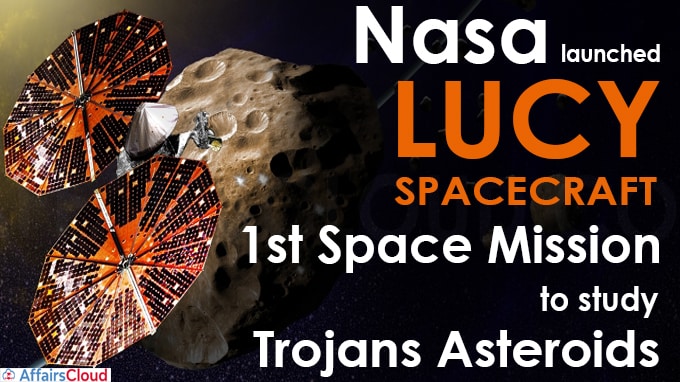 In October 2021, the National Aeronautics and Space Administration (NASA) launched the 12-year mission of ‘Lucy’, which is its 1st expedition to the Trojan asteroids of Jupiter to study the evolution of the solar system and the formation of giant planets.
In October 2021, the National Aeronautics and Space Administration (NASA) launched the 12-year mission of ‘Lucy’, which is its 1st expedition to the Trojan asteroids of Jupiter to study the evolution of the solar system and the formation of giant planets.
- The spacecraft Lucy was launched on a United Launch Alliance (ULA) Atlas V rocket from Space Launch Complex 41 at Cape Canaveral Space Force Station in Florida, United States.
- The mission will be powered by solar energy and it will run for 12 years and will visit 8 asteroids (7 Trojans, which are located in two separate swarms, ahead of and behind Jupiter in its orbit, and one in main belt) covering a distance of about 6.3 billion kilometres.
- The mission is named after ‘Lucy’, a 3.2 million-year-old preserved human skeleton from Africa, who belonged to a species of hominins (which is one of the oldest known human relatives).
What are Trojans?
i.The Trojan is a small celestial body (most of those are asteroids) that are leftovers from the early days of the solar system. It shares the orbit of a larger planet or of large moons.
ii.The Jupiter trojans asteroids are the swarm of asteroids that share Jupiter’s orbit around the Sun.
Key Points of the Mission:
i.During the mission, Lucy will spend 6 years cruising through the solar system and it would come back to the Earth 3 times to take assistance from the planet’s gravitational field to build up enough momentum to reach Jupiter.
- This makes the 1st-ever spacecraft return to Earth’s vicinity from the outer solar system.
ii.Lucy will study the geology, composition, density and structure of each of its Trojan targets.
iii.In 2025, Lucy will reach its first target of a small asteroid in the main belt between Mars and Jupiter named for Johanson (Asteroid 52246 Donald Johanson).
-NASA to Launch DART Mission for Preventing Asteroid Didymos from Striking Earth
After Lucy, the next mission of NASA was DART (Double Asteroid Redirection Test), which was scheduled to be launched on November 23, 2021, to prevent a hazardous near-earth binary asteroid Didymos from striking Earth.
Key Facts:
i.The asteroid Didymos consists of two bodies, the primary one being 780 meters in length and the secondary body (called moonlet) of about 160 meters. The secondary body is posing a threat of collision with Earth.
ii.NASA’s DART mission is aimed to collide with that secondary body of Didymos and change its orbital period by several minutes.
iii.The mission will work under the kinetic impactor technique and it will mark NASA’s 1st demonstration of an intercept path of near-Earth objects.
- Kinetic impaction– This technique involves sending one or more large, high-speed spacecraft into the path of an approaching near-earth object to change the direction of the asteroid into a different trajectory and moving it away from the Earth’s orbital path.
iv.The DART was scheduled to be launched from California’s Vandenberg Space Force Base through the SpaceX Falcon 9 rocket to reach Didymos.
-NASA set to Launch Psyche Mission to Study Metal-rich Asteroid
NASA also set to launch another mission named ‘Psyche’ to study the ‘Psyche asteroid’ that orbits the Sun in the main asteroid belt, between Mars and Jupiter. The mission will be intended to understand the formation of the early solar system.
- Psyche asteroid is 280 kilometres wide and it is largely made up of metals. This mission marks the 1st spacecraft launch to study an asteroid rich in metals rather than ice/dust.
- The spacecraft has been equipped with a magnetometer (to study the ancient magnetic field), a gamma-ray and neutron spectrometer, and a multispectral imager.
-NASA’s Deep Space Atomic Clock Successfully Completed Mission
General Atomics Electromagnetic Systems (GA-EMS) announced the successful completion of NASA’s Jet Propulsion Laboratory (JPL) Deep Space Atomic Clock (DSAC) mission.
- The DSAC was the primary payload onboard GA-EMS’ Orbital Test Bed (OTB) satellite that was launched on June 25, 2019.
- DSAC is a miniaturized, ultra-precise, mercury-ion atomic clock designed and built at NASA’s JPL for NASA Space Technology Mission Directorate’s Technology Demonstration Missions Program.
- The DSAC mission onboard the OTB satellite improved timing stability i.e it measured time consistently over long periods to support deep space navigation and exploration.
-Water vapour on Jupiter’s Europa:
NASA’s Hubble Space Telescope’s observations recorded water vapour in only one hemisphere of Jupiter‘s ocean moon Europa.
- Earlier in 2013, water vapour was observed in Europa in the form of ‘plumes erupting through ice’, which is to an extent, similar to geysers present on Earth.
Note – In October 2024, NASA plans to launch a probe called Europa Clipper, which will arrive in the Jupiter system in April 2030.
Recent Related News:
NASA plans to implement two new missions DAVINCI+ and VERITAS to Venus, Earth’s nearest also called sister planet. NASA will spend $500 million for each mission. Both missions will be expected to launch between 2028-2030.
About Jupiter:
i.Jupiter is the 5th planet from the Sun and it is the biggest planet in our solar system.
ii.Jupiter is a gas giant and it is made mostly of hydrogen and helium. They also have rings (but they are too faint to see very well). It has around 79 confirmed moons.
iii.Time: Since Jupiter rotates once about every 10 hours, one day on Jupiter goes by in 10 hours (a Jovian day). One year on Jupiter is the same as 11.86 Earth years.




